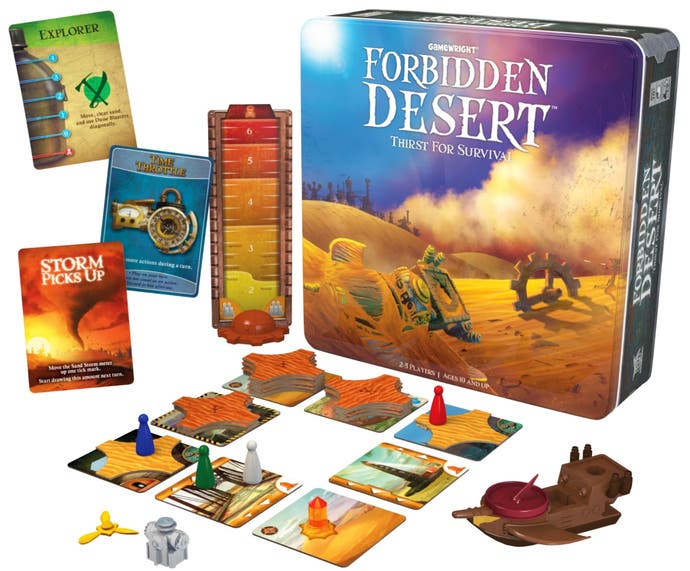Dicebreaker Recommends: Forbidden Desert, a family-friendly board game that builds rock-hard bonds between players
Sand together.
Dicebreaker Recommends is a series of monthly board game, RPG and other tabletop recommendations from our friends at our sibling site, Dicebreaker. Don't forget to also check-out their list of the best family board games.
Forbidden Desert is a board game about working together to escape a disastrous situation, which certainly doesn't echo with anything we're currently seeing in real life.
Good co-op games have a way of uniting players in order to achieve a shared goal. Forbidden Desert may chuck its players into a tense scenario, where failure lurks around every possible sand dune. But it also pushes players to support one another, hear each other out and use their unique abilities to overcome obstacles as a team.
Forbidden Desert is part of a series of board games created by Matt Leacock - the designer of another excellent co-op game, Pandemic - that places players in a variety of perilous situations, from sinking islands to stormy skies, which they must survive long enough to find an escape from.
In the case of Forbidden Desert, players take the role of adventurers who have ventured into a vast desert in order to discover a flying machine that's rumored to use the sun's rays as a power source. After your helicopter crash-lands due to a fierce sandstorm, players are forced to search for this mysterious machine as a means of escape - all whilst having to cope with the relentless sun, intense dehydration and piles upon piles of sand.
The game's board is made up of a five-by-five square grid of tiles, which are placed facedown in a random fashion. A gap is left in the middle of the grid to serve as the centre of the sandstorm. Some of these tiles contain parts of the machine that the players need to collect in order to construct it and fly away to safety. The search for these pieces is made exponentially more difficult by the excess sand being blown around by storm, causing certain tiles to be covered in increasingly large piles of the stuff.

At the end of every player's turn, they must draw a number of cards from the sandstorm deck equal to the current level of the storm - the higher the level, the more cards players must draw - and move the corresponding tiles in the direction indicated. This is one of the ways that Forbidden Desert introduces a real sense of adventure, by having the game board shift and change like sands in a storm.
The shifting sands mechanic doesn't just help with immersion, it also further complicates the ultimate goal of finding the machine pieces. Players must place a sand tile on top of every tile they move during the sandstorm phase, which prevents them from flipping the affected tiles over and discovering their secrets. What's more, tiles become impassable to almost all players once they have more than one sand tile on top of them. These tiles can be cleared if players use their actions to remove the sand, but the ever-changing landscape of the board means that players will have to consider all potential pathways to prepare for the worst-case scenario.
Luckily enough, players have access to certain abilities depending on which of the six possible roles they've chosen. These abilities are designed to work in tandem, providing players with plenty of opportunities to cooperate to navigate the game's shifting sands. For example, the navigator is able to move other players through unblocked tiles, whilst the archeologist can remove up to two sand tiles in a single action - the perfect combination for whenever the players need to clear an otherwise impassable route.
Other roles help with managing the threats posed by the sandstorm and the ever-present heat created by the desert sun. Players immediately lose the game if they ever run out of sand tiles to place on the board, making the meteorologist's ability to draw fewer sandstorm cards at the end of their turn - as well as look at and move cards to the bottom of the deck - helpful in avoiding a loss. The water carrier's ability, being able to take additional water from any discovered well tiles and give water to players on adjacent tiles, is a godsend for protecting thirsty players from dying of dehydration.
Aside from movement tiles, the sandstorm deck contains 'sun beats down' cards which force players to drink water from their canisters whenever they're drawn. (Unless a player has taken cover on a tunnel tile.) Running out of water means the demise of a player character and defeat for the entire party, which forces the everyone to support one another rather than attempt to go it alone. Even with each role's unique abilities and the promise of fancy gear - which can be discovered on hidden gear tiles - Forbidden Desert is very much a cooperative experience.
Which is why winning Forbidden Desert is such a satisfying experience. The player harmony required to keep the sand tiles under control, prevent anyone from dying of thirst, discover the location of the machine pieces and get everyone to the launchpad comes from everyone being willing to collaborate. In Forbidden Desert, teamwork is truly what makes the dream work.

